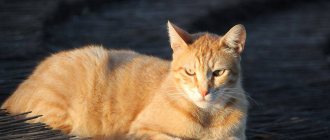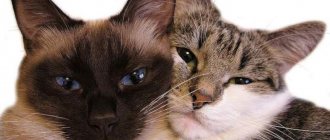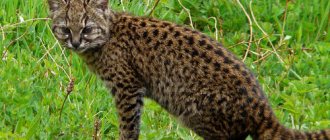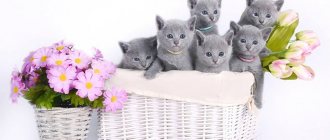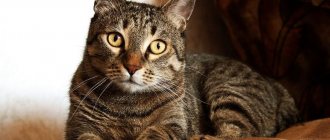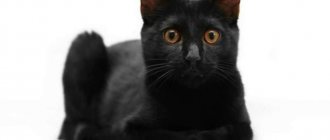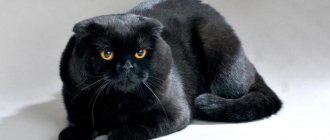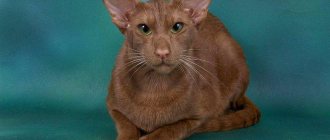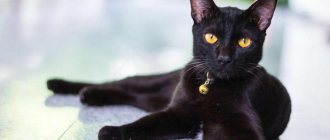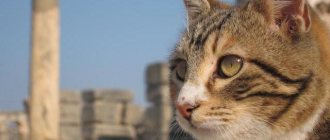History of the Skookum breed
In the 1990s, American breeder Roy Galusha came up with the idea of breeding a hybrid of laperms and munchkins. LaPerm is a breed of cat with a “perm”, that is, small curls on the coat. Munchkin is a dwarf cat, a dachshund cat with very short legs. Roy wanted fluffy and curly little animals. Years of hard breeding work have yielded results. When munchkins and laperms were crossed, bizarre dwarf creatures with curly hair were born. In 1996, the first Skookum kittens were born.
By the way, this name was not given to the breed right away. Roy initially wanted to call his invention the Mexican Poco Chino. The American believed that this phrase translated as “little curly.” Upon further investigation, Mr. Galusha realized that "Poco Chino" means "a little Chinese" in Spanish. China had nothing to do with the laperm-munchkin hybrid, so the option turned out to be unsuccessful.
In search of a great name for his small breed, Roy turned to the Chinook Indian dictionary. There he came across the Native American word "skookum" (or "skokum"), which means "impressive, strong, unbending."
The breeder liked the word. Moreover, he considered the representatives of the new breed to be exactly the same in character - strong and stubborn, with an unbending core inside.
For 10 long years, Roy worked independently on breeding the Skookum breed. When he managed to consolidate the breed-forming characteristics, and the Skookum gene pool became wider, he submitted an application to TICA for registration.
The largest international felinological organization became interested in the new breed. In 2006, the Skookum was given experimental breed status. There is no talk of official registration yet.
Very soon, curly dwarf pussies set off to conquer other countries. The TDCA, which specializes exclusively in dwarf and very small cats, has recognized the Skookum as an official breed. The Australian organization WNCA not only officially registered the breed, but also awarded the Skookum champion status.
Character and behavior
Kinkalows are attractive not only for their original appearance, but also for their character. These are cute, friendly creatures that retain the playfulness and naivety of a kitten until old age. They are very contactable and people-oriented, but they are rarely overly intrusive if they see that the owner is not in the mood and are always ready to support the company when attention is paid to them. They love affection and always try to be in the center of events.
The gentle nature of the Kinkalow makes them excellent companions for people of all ages, experienced and novice cat owners.
Short stature does not prevent them from leading a full life. Kinkaloos are no less active than their long-legged counterparts and often prefer to watch everything at a height, on a table, on a cabinet or on a refrigerator. They are very inquisitive and will definitely get to the thing that interests them. They easily get along with other pets. They get along with children of different ages. It is not typical for them to display aggression. In conflict situations, they will prefer to leave. As for the voice, kinkalows are not very “talkative”; they meow not loudly, only when they ask for food or need something else.
Description of Skookum
Surprisingly, Skookums are larger than their Munchkin parents. And in other respects they differ significantly from both munchkins and laperms. Cats are considered dwarf, but they have medium body sizes. Mature males weigh about 4 kg, females - 2-3 kg.
Similarities with other dwarf breeds include short stature, stockiness and stockiness.
Skookum breed standard
The croup and shoulders are strong and broad, the chest is also widened. The paws were inherited from munchkins; they are objectively short and strong. The head is small, wedge-shaped, but with rounded outlines.
Cheeks are plump. The mustache and eyebrows are long and wavy. The nose is short, the chin is powerful and prominent. The ears are small, wide at the base, and pointed at the tips.
The eyes are medium sized and almond shaped. Many people compare animal eyes to lemons: they appear round, but the pointed corners resemble a sour fruit.
The neck is short and dense. The tail is neither thin nor thick, medium in length, sometimes short.
Skookum color
The coat is very similar to that of the Laperma. In countries where Skookum is not a separate breed, its representatives are often called “dwarf laperm”, emphasizing the relationship.
Skookums come in long-haired and short-haired varieties. The fluffy and curly collar on the short neck is clearly visible. The longer the coat, the more the hair curls.
Short-haired animals have fur that is hard and rough to the touch. In long-haired cats, the hairs tend to become matted and tangled in knots.
The breed standard does not make any requirements regarding the color of the animal. Officially, a cat can be any color.
Skookum character
At first, dwarf laperms seem shy and hesitant. But you should not mistakenly believe that these are shy and timid animals. Their character is accurately reflected in the name of the breed: they are strong, fearless and self-confident animals.
They are not social phobics, they love communication with their owner, but do not depend on him. If everyone in the household is very busy, Skookum will have a great time on his own. Independent and calm, fluffy cats do not become depressed if they are left alone for a long time.
These are very quiet cats. Literally from birth they behave quietly; a loud “meow” from the mouth of a skookum is very rare. They usually purr quietly or squeak barely audibly under their breath.
Skookum is playful, sociable and cheerful. Despite their shortened legs, these are very agile and nimble pets.
Skookum health
In matters of health, it will again be relevant to refer to the name of the breed. These are healthy, strong animals, their immunity is truly “unbending” against the onslaught of infections and diseases.
No genetic diseases have been detected in cats. Of course, the breed is still too young to judge the health of Skookums. But to date, not a single sick animal has been recorded.
Good genetics will not save Skookum from cat infections and illnesses. But vaccinations can save. Therefore, you should not neglect scheduled vaccinations and regularly visit the veterinarian, even if nothing bothers you and your pet.
.
It wouldn't hurt to treat your pet for parasites. If Skookum goes outside for walks, veterinarians advise periodically worming the pet and checking the wavy coat for fleas.
The lifespan of the curly dwarf is from 12 to 15 years.
What do kinkalows look like?
Kinkaloos are distinguished by their original appearance, which makes them difficult to confuse with any other breed. They have short legs and folded back ears. Both male and female cats are miniature, and also very short. Height at the withers is about 20 cm. Weight is about 3 kg.
The cat's head and body, while rounded in appearance, should remain flexible with well-developed but not prominent muscles, and not appear bulky or clumsy. The plump legs are spaced evenly. The front ones are usually slightly shorter than the rear ones. Tails are often longer than the body. Kinkaloo kittens are born with straight ears. They begin to bend in the first week of life and are finally formed by 5 months. Part of the auricle is bent back at an angle of 90-180 degrees.
The coat is soft, thick with a well-developed undercoat. Can be short or long. Colors can be very diverse.
Skookum care
But when it comes to keeping them, these are not the easiest pets. A cat's curly coat requires careful care. In long-haired individuals, tangles occur every now and then. For this reason, matted wool is cut off once a month. A capricious cat needs to be brushed 1-2 times a week.
Skookums are calm about water. They bathe cats at least once a month and use special cat shampoo for curly breeds.
There is one secret how to emphasize the curly fur of a Skookum and avoid a large number of tangles. You need to spray the fur with water from a spray bottle from time to time. The eyes should be wiped with a clean damp cloth or damp disc every week. Nails are trimmed twice a month.
Feeding Skookum
The condition of the long wavy coat directly depends on the animal’s nutrition. If your pet lacks vitamins and microelements, the animal will look drooping, dull and even shabby. The fur will become more tangled, fall out, and lose at least some attractiveness. Be sure to take care of your cat's balanced diet. The best option would be to feed premium dry food for purebred cats. You can feed with natural products. The menu is based on lean meat. Offal and fermented milk products are useful. Do not give your skookum milk or raw fish. Additionally, it is necessary to give special vitamin complexes for cats. They will eliminate the lack of essential microelements.
Content Features
Kinkaloos easily adapt to any living conditions; in general, they are full-fledged cats, despite their small stature and curved ears. But it is important to remember that they are not distinguished by the feline independence that is inherent in most representatives of their “tribe”. Kinkaloos are very sociable and need attention and regular play together. They value coziness and comfort, which is why they often love various houses and beds.
Considering that Kinkaloo cats are very energetic and playful cats, they must have toys and a playground at home.
At a young age, kinkalows are accustomed to walking on a leash, although it is worth noting that many cats live happily without ever leaving the apartment. In a private home, people are happy to go outside to bask in the sun and hunt for insects. They may show interest in small animals, but rarely have a pronounced hunting instinct and ability to catch rodents. Cats prefer not to leave the yard, and cats, like the most ordinary ones, can go on a love search. If a cat is not of breeding value, it is better to castrate him. In such sprees, short-legged animals face a sea of dangers. It will be difficult for them to resist ordinary cats in fights, deftly avoid meeting a dog or dodge a car. In addition, there is a risk of contracting something from other cats or being stolen.
Buy Skookum
Skookums are rare cats.
In Russia they are a real exclusive. There is not a single official nursery in the CIS countries. Skookums are bred only in European and American nurseries. Finding a dwarf curlytail on private message boards is a great success. Before concluding a deal, check everything thoroughly and think it over.
Health and life expectancy
Thanks to the fact that breeding work was started correctly, the Kinkaloo is one of the healthiest breeds today. They are very hardy and absolutely unpretentious. Of course, this does not mean that you can experiment on a cat, leave it on the street, feed it anything, or forget about basic veterinary preventive measures (timely vaccination, treatment against external and internal parasites). Kinkaloos can develop any of the cat diseases, they just do not have certain genetic abnormalities and predispositions to specific diseases. It is worth noting that the breed is on the path of development and, perhaps, some problems will be identified in the future. The life expectancy of the Kinkalow is usually 12-14 years; long-livers are often found among cats of this breed.
brief information
- Breed name: Skookum
- Country of Origin: USA
- Weight: 3 – 4 kg
- Lifespan: 12 – 15 years
Skookum is a breed of dwarf cat with curly hair, a dense build and short but strong legs. They are very playful and loving in nature. At the moment, Skookum cats are expensive and rare; they can only be bought in nurseries in Europe and the USA.


